Unknown Unknown Result Decisive Crusader victory | Dates 12 Apr 1204 – 13 Apr 1204 | |
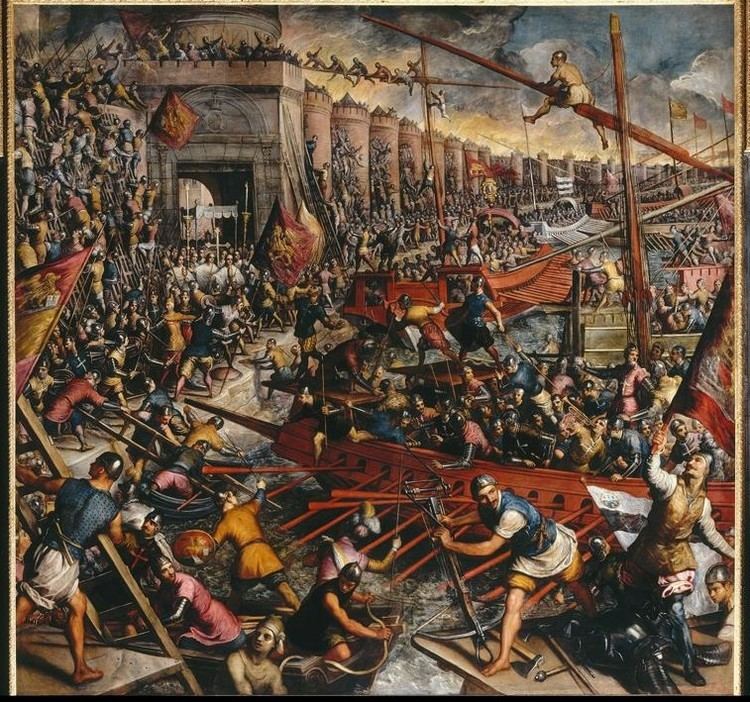 | ||
Byzantines 15,000 men,Byzantines 20 ships Crusaders 10,000 menVenetians 10,000 menVenetians 210 ships Similar Fourth Crusade, Fall of Constantinople, Crusades, First Crusade, Third Crusade | ||
The sack of constantinople 1204 by the crusaders
The Sack of Constantinople or Siege of Constantinople occurred in 1204 and marked the culmination of the Fourth Crusade. Mutinous Crusader armies captured, looted, and destroyed parts of Constantinople, the capital of the Byzantine Empire. After the capture, the Latin Empire was created and Baldwin of Flanders was crowned Emperor Baldwin I of Constantinople in the Hagia Sophia.
Contents
- The sack of constantinople 1204 by the crusaders
- Before the siege
- Siege
- Capture of the city
- Sack of Constantinople
- Aftermath
- Legacy
- References
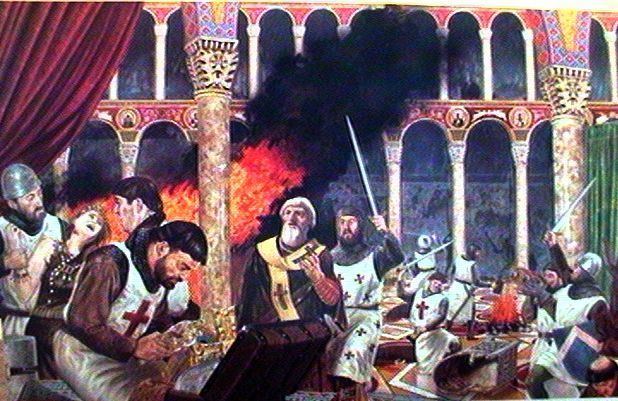
After the city's sacking, most of the Byzantine Empire's territories were divided up and controlled by the Crusaders. Byzantine aristocrats also established a number of small independent splinter states, one of them being the Empire of Nicaea, which recaptured Constantinople in 1261 and proclaimed the reinstatement of the Empire. However, the restored Empire would never return to its former territorial or economic status, and eventually fell to the rising Ottoman Sultanate in the 1453 Siege of Constantinople.

The sack of Constantinople is a major turning point in medieval history and Christianity more generally. The Crusaders' decision to attack a major Christian capital was unprecedented and immediately controversial, even among the Crusaders themselves. Relations between the western and eastern Christian worlds were severely wounded and would not fully recover for hundreds of years afterwards, and the Byzantine Empire became poorer, smaller, and less able to defend itself against the Turkish conquests that followed. The Fourth Crusade therefore left Christendom more divided and weakened than before.
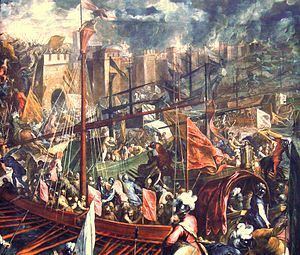
Before the siege
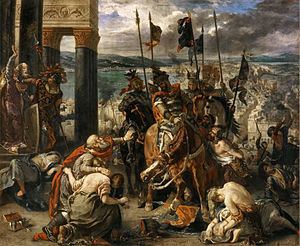
The Massacre of the Latins (Italian: Massacro dei Latini; Greek: Σφαγή τῶν Λατίνων), a large-scale massacre of the Roman Catholic or "Latin" inhabitants of Constantinople by the Eastern Orthodox population of the city in May 1182, had a dramatic effect on the schism between the Western and Eastern Christian churches. The massacre also further worsened the image of the Byzantines in the eyes of the Western powers, and, although regular trade agreements were soon resumed between Byzantium and Latin states, the underlying hostility would remain, leaving many westerners seeking some form of revenge.
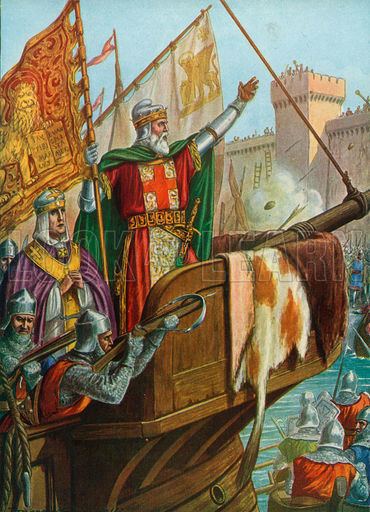
Following the siege of Constantinople in 1203, on 1 August 1203, the pro-Crusader Alexios Angelos was crowned Emperor Alexios IV of the Byzantine Empire, who then tried to pacify the city. But riots between anti-Crusader Greeks and pro-Crusader Latins broke out later that month and lasted until November, during which most of the populace began to turn against Emperor Alexios IV.
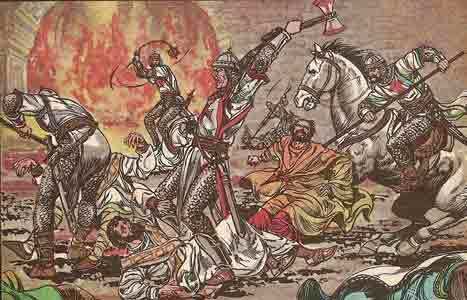
On 25 January 1204, the death of co-Emperor Isaac II set off rioting in Constantinople in which the people deposed Alexios IV, who turned to the Crusaders for help but was imprisoned by the imperial chamberlain, Alexios Doukas, who declared himself Emperor on 5 February. Emperor Alexios V then attempted to negotiate with the Crusaders for a withdrawal from Byzantine territory, but they refused to abandon their old treaty with Alexios IV. When Alexios V ordered Alexios IV's execution on 8 February, the Crusaders declared war on Alexios V. In March 1204, the Crusader and Venetian leadership decided on the outright conquest of Constantinople, and drew up a formal agreement to divide the Byzantine Empire between them.
Siege
By the end of March, the combined Crusader armies were besieging Constantinople as Emperor Alexios V began to strengthen the city's defences while conducting more active operations outside the city. By the first week of April, the Crusaders had begun their siege from their encampment in the town of Galata across the Golden Horn from Constantinople.
On 9 April 1204, the Crusader and Venetian forces began an assault on the Golden Horn fortifications by crossing the waterway to the northwest wall of the city, but, because of bad weather, the assault forces were driven back when the troops that landed came under heavy archery fire in open ground between Constantinople's fortifications and the shore.
Capture of the city
On 12 April 1204 weather conditions finally favoured the Crusaders as the weather cleared and a second assault on the city was ordered. A strong north wind aided the Venetian ships near the Golden Horn to come close to the city wall, which enabled the attackers to seize some of the towers along the wall. After a short battle approximately 70 Crusaders managed to enter the city. Some Crusaders were eventually able to knock holes in the walls large enough for a few knights at a time to crawl through; the Venetians were also successful at scaling the walls from the sea, although there was extremely bloody fighting with the Varangians. The Crusaders captured the Blachernae section of the city in the northwest and used it as a base to attack the rest of the city, but while attempting to defend themselves with a wall of fire they ended up burning down even more of the city. Emperor Alexios V fled from the city that night through the Polyandriou (Rhegium) Gate and escaped into the countryside to the west.
Sack of Constantinople
The Crusaders looted, terrorized, and vandalized Constantinople for three days, during which many ancient and medieval Roman and Greek works were either stolen or destroyed. The famous bronze horses from the Hippodrome were sent back to adorn the façade of St Mark's Basilica in Venice, where they remain. As well as being stolen, works of immeasurable artistic value were destroyed merely for their material value. One of the most precious works to suffer such a fate was a large bronze statue of Hercules, created by the legendary Lysippos, court sculptor of Alexander the Great. Like so many other priceless artworks made of bronze, the statue was melted down for its content by the Crusaders. The great Library of Constantinople was destroyed as well.
Despite their oaths and the threat of excommunication, the Crusaders systematically violated the city's holy sanctuaries, destroying or stealing all they could lay hands on; nothing was spared, not even the tombs of the emperors inside the St Apostles church. The civilian population of Constantinople were subject to the Crusaders' ruthless lust for spoils and glory; thousands of them were killed in cold blood. Women, even nuns, were raped by the Crusader army, which also sacked churches, monasteries and convents. The very altars of these churches were smashed and torn to pieces for their gold and marble by the warriors. Although the Venetians engaged in looting too, their actions were far more restrained. Doge Dandolo still appeared to have far more control over his men. Rather than wantonly destroying all around like their comrades, the Venetians stole religious relics and works of art, which they would later take to Venice to adorn their own churches.
It was said that the total amount looted from Constantinople was about 900,000 silver marks, or 600,000 troy pounds. The Venetians received 150,000 silver marks that was their due and the Crusaders received 50,000 silver marks. A further 100,000 silver marks were divided evenly between the Crusaders and Venetians. The remaining 500,000 silver marks were secretly kept back by many Crusader knights. Meanwhile, Latin residents of Constantinople exacted their own retribution for the Massacre of the Latins of 1182.
Aftermath
According to a prearranged treaty the empire was apportioned between Venice and the crusade's leaders, and the Latin Empire of Constantinople was established. Boniface was not elected as the new emperor, although the citizens seemed to consider him as such; the Venetians thought he had too many connections with the former empire because of his brother, Renier of Montferrat, who had been married to Maria Comnena, empress in the 1170s and 80s. Instead they placed Baldwin of Flanders on the throne. He was crowned Emperor in the Hagia Sophia as Baldwin I of Constantinople. Boniface went on to found the Kingdom of Thessalonica, a vassal state of the new Latin Empire. The Venetians also founded the Duchy of the Archipelago in the Aegean Sea.
Most of the Byzantine aristocracy fled the city. Amongst the ordinary people of the former empire there was no sympathy for the Byzantine elite, who were seen as having ruled the empire with increasing incompetence. The contemporary Byzantine historian and eye-witness Nicetas Choniates closed his account of the fall of the city with the following description of a column of aristocratic refugees, including the Patriarch, making their way to Selymbria:
The peasants and common riff-raff jeered at those of us from Byzantium and were thick-headed enough to call our miserable poverty and nakedness equality...Many were only too happy to accept this outrage, saying "Blessed be the Lord that we have grown rich", and buying up for next to nothing the property that their fellow-countrymen were forced to offer for sale, for they had not yet had much to do with the beef-eating Latins and they did not know that they served a wine as pure and unmixed as unadulterated bile, nor that they would treat the Byzantines with utter contempt.
Byzantine aristocratic refugees founded their own successor states, the most notable of these being the Empire of Nicaea under Theodore Lascaris (a relative of Alexius III), the Empire of Trebizond and the Despotate of Epirus.
The sack weakened the Byzantine Empire, which allowed neighboring (or neighbouring) groups such as the Sultanate of Rum, and later the Ottoman Turks, to gain influence (see the Byzantine–Ottoman Wars).
Legacy
Eight hundred years after the Fourth Crusade, Pope John Paul II twice expressed sorrow for the events of the Fourth Crusade. In 2001 he wrote to Christodoulos, Archbishop of Athens, saying, "It is tragic that the assailants, who set out to secure free access for Christians to the Holy Land, turned against their brothers in the faith. The fact that they were Latin Christians fills Catholics with deep regret." In 2004, while Bartholomew I, Patriarch of Constantinople, was visiting the Vatican, John Paul II asked, "How can we not share, at a distance of eight centuries, the pain and disgust?" This has been regarded as an apology to the Greek Orthodox Church for the slaughter perpetrated by the warriors of the Fourth Crusade.
In April 2004, in a speech on the 800th anniversary of the capture of the city, Ecumenical Patriarch Bartholomew I formally accepted the apology. "The spirit of reconciliation is stronger than hatred," he said during a liturgy attended by Roman Catholic Archbishop Philippe Barbarin of Lyon, France. "We receive with gratitude and respect your cordial gesture for the tragic events of the Fourth Crusade. It is a fact that a crime was committed here in the city 800 years ago." Bartholomew said his acceptance came in the spirit of Pascha. "The spirit of reconciliation of the resurrection... incites us toward reconciliation of our churches."
